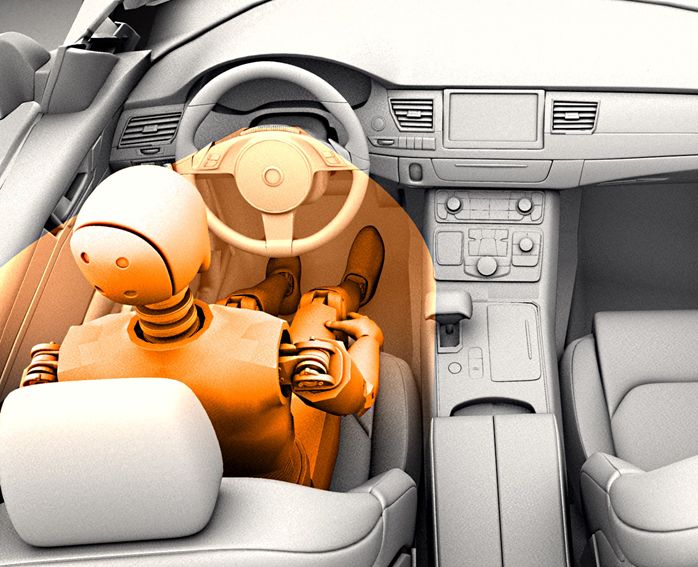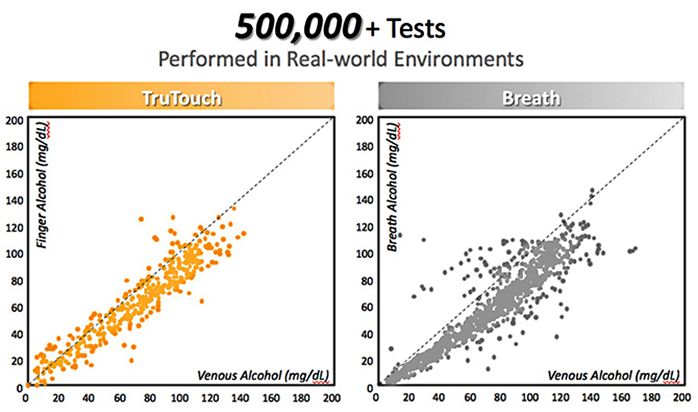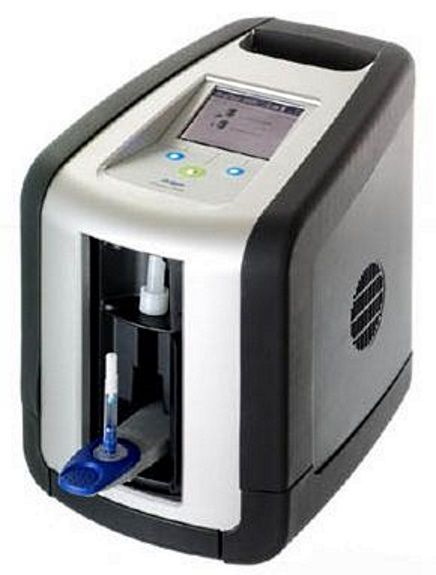 触摸酒精检测传感器可能会内置在车辆启停键内,面向驾驶员一侧。(DADSS)
触摸酒精检测传感器可能会内置在车辆启停键内,面向驾驶员一侧。(DADSS) 基于呼吸的酒精传感器可以安装在方向盘附近的转向柱上,也可以安装在司机的侧门上.。(DADSS)
基于呼吸的酒精传感器可以安装在方向盘附近的转向柱上,也可以安装在司机的侧门上.。(DADSS) TruTouch技术公司使用工业接触式酒精探测器和呼吸式酒精探测器的比较数据显示,这两种技术都达到了最先进的水平。(TruTouch)
TruTouch技术公司使用工业接触式酒精探测器和呼吸式酒精探测器的比较数据显示,这两种技术都达到了最先进的水平。(TruTouch) 这个毒品测试仪可以识别唾液中的安非他明、阿片剂、可卡因、大麻、美沙酮和其他管制毒品。(Dragerwerk AG)
这个毒品测试仪可以识别唾液中的安非他明、阿片剂、可卡因、大麻、美沙酮和其他管制毒品。(Dragerwerk AG)
虽然车企在新车上引入了各种主被动安全系统,但美国的机动车致死率仍然是居高不下。每年依然约有4万人被机动车事故夺去生命,尽管其中6000人是行人,而且有些也不是因车祸丧生,但这个总数还是触目惊心。
而在机动车致死事故中,28%(约10,000人)都是和酒驾有关。在美国,如果驾驶员每100毫升的血液中酒精含量超过0.08克(80毫克),即判断为酒驾。犹他州今年更是将血液酒精浓度(BAC)的标准下调到了0.05克/100毫升。在致使行人死亡的事故中,有13%的驾驶员和33%的行人是处于醉酒状态。
尽管执法部门的打击力度不断,酒驾问题依然十分棘手。这也促使车企开始研发车载BAC检测设备,希望能借此准确地识别出醉酒司机,阻止其驾驶车辆。
正在测试中的红外线技术
目前,有一个研究机构正在探索基于呼气和手指触摸的两类红外线检测技术。该科研项目是由美国高速公路交通安全管理局(NHTSA)和由16家整车企业组成的交通安全汽车联盟(ACTS)资助,目前已开展了九年。参与研究的还有一些交通安全领域的非政府组织。项目全名为“驾驶员酒精安全检测系统”,简称DADSS。
不同于需要被测者深呼气的警用呼气测定仪,DADSS的呼气检测系统只需接收驾驶员正常呼气,然后传感器发出红外线的波束会穿过主要为二氧化碳的呼出气体,再由电子模块分析回波。由于红外线的波长会根据穿透气体的浓度而变化,模块便可以据此分析出样本气体的酒精浓度。
这和某些红外线汽车空调制冷剂识别及泄露探测设备的工作原理有些相似。
DADSS的另外一种系统是触摸检测,该设备可能会被内置在发动机启动键内。其工作原理是照亮指尖并发射红外线,使其穿透皮肤进入指尖的毛细血管,然后和呼气检测一样,红外线波束反射回传感器。在特殊滤波器的帮助下,触摸检测系统可以探测到两种可以反映酒精的波长。
两种DADSS检测技术都能快速呈现读数。触摸检测系统可在一秒之内显示多个读数,而呼气检测系统因为需要等待驾驶员呼气,所以相对慢一些,但是一旦呼气采集成功,也能立刻呈现出读数。
然而,尽管这两种系统在技术上已经可行,但离真正应用还需进一步探索。设备的尺寸必须缩小到智能手机的大小,而且还不能牺牲反应速度。而且,不论环境条件如何,硬件都必须保持准确可靠。当然设备还必须保证与驾驶员的行为无缝衔接,也就是说,一旦检测出驾驶员有酒驾的可能性,无论他采取任何常规的行动,设备都必须发出“发动机不会启动”的信号。
同时,系统必须能有效避免攻击策略。该项目的设备采用了六西格玛(99.9997%)质量标准和美国国防部技术制造成熟度评价等级。
呼气仿真机
DADSS呼气检测系统的原型机测试采用了常用的实验方法 ——使用人体呼气仿真设备,通过结合二氧化碳、氮气、氧气和适量水气,生成和人体一样的呼气,然后在进行酒精浓度检测实验时加入乙醇。
仿真设备的呼气还可以还原空中的灰尘、温度变化和不同的人体动作。
此外,研究人员也还在研究应当把传感器放在哪里,可能的两个选项是驾驶员一侧的车门和转向柱。同时,为了更有效地区分驾驶员和乘客的呼气,研究人员也在探讨安装多个传感器的价值和必要性。
呼气系统的传感器由两家瑞典公司——Senseair和汽车安全系统供应商奥托立夫共同研发而成。
触摸检测系统的研究方法和呼气系统截然不同。鉴于每个人的皮肤厚度不同,研发人员采用了模拟人体组织的仿真校准设备。当然,真实的人体测试也在同步进行。检测系统正在由美国TruTouch科技公司研发,该公司原本的产品是用于检测员工是否在上班前饮过酒。TruTouch的数据表明,虽然设在公司门口的触摸检测系统的速度比车内的慢,但它的准确性还是和呼气检测一样高。
触摸设备应仅限驾驶员一人使用,因此,需要高级验证技术来确保坐在驾驶座上的是真正的司机,比如,可以结合脸部识别传感器和坐姿驾驶员传感器。按照目前的配置,除非驾驶员是以坐姿按下启动键,否则系统都不会发出有效的发动机启动信号。
DADSS红外线检测系统可能会成为未来的车辆配置。尽管系统将从今年开始上车进行实地测试,但是离量产还是尚有时日。另外值得一提的是,虽然禁止发动机启动的BAC基线为0.08,但父母可以为21岁以下的驾驶员设置更低的限值。
两种检测系统都可以迅速重设。不合规的司机可以找人代驾,或休息片刻后重测。
毒驾也需谨防
在道路安全部门和执法部门大力实施酒驾法规的同时,NHTSA也在打击毒驾。关于酒驾的数据多如牛毛,但有关毒驾的负面影响的数据却是寥寥无几。人们通常引用的全美毒驾的数据其实是来源于个别州或简单的问卷调查,这些州的警力都受过毒驾的稽查培训。
根据NHTSA的数据显示,大麻是最常用的毒品,2013年,周末夜间的毒驾比例已从2007年的16.3%上升到了20%。此外,由于大麻在很多州被合法化和执法标准的缺位,连唾液、汗液的测试都成了难题,根本无法获得基本数据。当警察找到毒驾的证据后,按照美国法律可以进行视觉测试,比如要求驾驶员做行走测试,这种做法虽然有时候会得到法院的认可,但现在还是没有一个关于“毒驾”的普遍认可的法律定义,也缺乏真正的执法行动。
不过,一些地区已经在使用毒品测定仪,比如密歇根州和加拿大,密歇根州更是从法律上禁止了毒驾。典型的测定仪可以在一两分钟之内检测出最常用的几类毒品。
Despite the introduction of active and passive safety systems installed on new vehicles, the U.S. motor vehicle death rate remains high, currently some 40,000 persons. Although this number includes 6,000 pedestrians (and not all deaths involved a crash), the total is alarming.
And significantly, 28% of all motor vehicle fatalities—over 10,000 persons—involve an alcohol-impaired driver, with a blood-alcohol content level (BAC) of at or over of 0.08, or 80 mg alcohol per deciliter of blood. (Utah is lowering its BAC limit to 0.05 this year). In accidents that result in a pedestrian fatality, 13% of the drivers and 33% of the pedestrians involved were alcohol-impaired.
Despite efforts by law enforcement to identify alcohol-impaired drivers, the problem remains. This has led to intensified work on development of in-car detection of high-BAC sensing equipment that can accurately detect a drunken driver and prevent him from starting and driving a car.
Infra-red technologies in testing
There are two infra-red technologies under current investigation by a research consortium, one system that is breath-based, another that is finger touch-based. The work, underway for nine years, is sponsored by NHTSA and the Automotive Coalition for Traffic Safety (ACTS), an organization of 16 vehicle OEMs. Also participating is a host of traffic safety NGOs. The project is called the Driver Alcohol Detection System for Safety, or DADSS.
The breath-based system is not like the breathalyzer used by police, which requires a deep-breath air sample for analysis. Rather, it takes a sample of the driver’s normal exhalation, which is primarily carbon dioxide. The sensor directs infra-red beams through it, and an electronic module analyzes the return waves. Because infra-red wavelengths vary according to the concentrations of different gasses through which they pass, the percentage of alcohol in the sample can be measured by the module.
This operating principle is somewhat akin to the operation of infra-red type automotive A/C refrigerant identifiers, and to some A/C refrigerant leak detectors.
The touch-based device, which likely would be built into an engine start button, illuminates and sends infra-red light through the skin into the capillaries of the fingertip. Like the breath-based system, infra-red beams are reflected back into the sensor. The touch-based system, using specific filters, looks for the two wavelengths that indicate the presence of alcohol—and only those wavelengths.
Both technologies have been developed to the points where they can take readings very quickly. The touch-type is being tuned to take several readings in under a second. The breath type is reportedly not nearly as fast, because of its type of operation (waiting for the driver to exhale), but the system response is instantaneous once the sample is taken.
Although the two systems are technically feasible, making them technologically usable requires continued research. The hardware must shrink in size, and the objective is to make it the size of a smartphone, while maintaining its fast action. However, its precision and reliability under all environmental conditions still must be proved. And of course, the technology must operate seamlessly, that is produce an engine-will-not-start signal with all-natural actions by the driver.
The systems also have to be reasonably resistant to defeat tactics. The program’s equipment quality level is set at Six Sigma (99.9997%) plus U.S. Department of Defense technology/manufacturing readiness levels.
Breath simulator
The prototype testing for the breath-based system lends itself to a long-employed laboratory approach: use of a simulator, in this case for human breath. It produces an artificial equivalent to human breath, by combining carbon dioxide, plus some nitrogen and oxygen, and normal amounts of moisture. Ethanol is added in test concentrations for alcohol identification.
Airborne dust, and changes in temperatures and the simulation of a wide range of human movements all can additionally be incorporated.
Also in the research stage is location of the sensor, with the driver’s side door and steering column among the possibilities. In addition, the research teams are looking at the possible value or need to use more than one sensor, to identify locations that would positively separate the driver’s breath sample from those of passengers.
The system was developed by a pair of Swedish companies—the sensor by Senseair, working with an automotive safety supplier, Autoliv Development.
Touch-based detection research must take a totally different approach; a calibration device was developed that simulates characteristics of human tissues—because each person’s skin is of different thickness. In addition, of course, actual human testing has been underway. The system is being developed by TruTouch Technologies, a U.S. company that makes devices to detect alcohol impairment in workers arriving at a workplace. Its data shows a virtually exact match in accuracy compared with breath-based systems, although its work-entry devices are not designed to perform with the same speed as its automotive touch system.
Ensuring that a touch device is used by the driver alone will require a high level of verification that the actual driver is in the seat. It could be a combination of a facial-recognition sensor and a seated driver presence sensor. As currently configured, the system will not generate a valid engine-start signal if other than a seated driver presses the start button.
The system would be a vehicle option, and although vehicle installations and field testing is starting this year, the consortium has not gone beyond “a step closer” assessment of OE production. Although the BAC detection would be set at 0.08, a parent would be able to program the device to a no-start for drivers under 21, with an even lower BAC level if desired.
Instant reset is a feature of either system, so a designated driver could take over, or the motorist could take a nap and retest himself later.
Drug impairment needs attention
While safety agencies and law enforcement are working to enforce drunk driving laws, NHTSA also is looking at drug-impaired motorists. Although there is profuse data on alcohol impairment, there is little on the adverse effect of drug use. The data that is nationally cited is from the few states that have police officers trained to detect it, and simple Q&A surveys.
NHTSA data shows that use of marijuana, the most common drug, rose from 16.3% in 2007 to 20% in a 2013-14 survey of nighttime, weekend drivers. However, with marijuana legal in many jurisdictions, and no standards in force, even the availability of saliva/sweat testers are little more than sources of basic data. State laws on evidence of impaired driving, followed by police-performed visual tests (driver walking, etc.), are sometimes acceptable in court, but widely-accepted legal definition and real enforcement still are in their infancy.
Several drug testers are in use, both in states like Michigan which has legal restrictions on drugged driving, and Canada. The typical tester can perform an analysis in a couple of minutes, identifying most commonly used drugs.
Author: Paul Weissler
Source: SAE Automotive Engineering Magazine
等级
打分
- 2分
- 4分
- 6分
- 8分
- 10分
平均分
